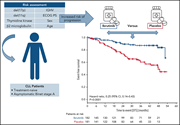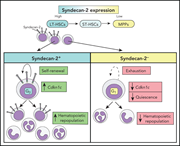Issue Archive
Table of Contents
BLOOD COMMENTARIES
REVIEW ARTICLE
Targeting cholesterol homeostasis in hematopoietic malignancies
Cholesterol is a multifaceted molecule that regulates cell permeability and integrity and inflammatory responses. Brendolan and Russo review the role of cholesterol homeostasis in hematological malignancies, as well as in cells of the tumor microenvironment, and discuss the potential use of lipid modulators for therapeutic purposes based on existing preclinical data.
CLINICAL TRIALS AND OBSERVATIONS
The CLL12 trial: ibrutinib vs placebo in treatment-naïve, early-stage chronic lymphocytic leukemia
Clinical Trials & Observations
Langerbeins and colleagues report the first randomized study of early intervention with a novel targeted agent in patients with asymptomatic chronic lymphocytic leukemia (CLL). The data indicate that treatment of patients with early-stage CLL bearing unfavorable prognostic factors, but not yet meeting standard criteria for initiation of therapy, are less likely to experience symptomatic progression if commenced on ibrutinib than a placebo. Further follow-up is required to determine whether these data have any implication for routine practice.
HEMATOPOIESIS AND STEM CELLS
Syndecan-2 enriches for hematopoietic stem cells and regulates stem cell repopulating capacity
Transcriptomic studies of hematopoietic stem cells (HSCs) have revealed increased expression of the gene encoding syndecan-2, a heparan sulfate proteoglycan. Using classical cell sorting, functional and transplant studies, Termini and colleagues identified syndecan-2 as a useful cell surface marker to enrich long-term repopulating murine HSCs, and they demonstrate its importance in regulating HSC self-renewal via control of stem cell quiescence.
IMMUNOBIOLOGY AND IMMUNOTHERAPY
LYMPHOID NEOPLASIA
Incidence of lymphoid neoplasms among atomic bomb survivors by histological subtype, 1950 to 1994
Clinical Trials & Observations
Distinct roles for PARP-1 and PARP-2 in c-Myc–driven B-cell lymphoma in mice
CXCR4 PET/MRI for follow-up of gastric mucosa–associated lymphoid tissue lymphoma after first-line Helicobacter pylori eradication
Brief Report
CXCR is overexpressed in mucosa-associated lymphoid tissue (MALT) lymphoma. Mayerhoefer et al report the prospective assessment of a CXCR4-targeting positron emission tomography (PET) tracer for the noninvasive response assessment of gastric MALT lymphoma. By prospectively analysing68 Ga-pentixafor PET images and using time-matched gastric biopsies, they demonstrate that this imaging modality accurately identifies residual gastric MALT lymphoma after Helicobacter pylori eradication with a sensitivity of 95%.
MYELOID NEOPLASIA
ALK-positive histiocytosis: a new clinicopathologic spectrum highlighting neurologic involvement and responses to ALK inhibition
Clinical Trials & Observations
Understanding the biology of histiocytic neoplasms has enabled the rational application of targeted therapies for these rare diseases. Kemps and colleagues report clinicopathologic, molecular, treatment, and follow-up data in a large cohort of patients with a recently recognized disease entity, ALK-positive histiocytosis. The disease is tightly associated with KIF5B-ALK fusions, and ALK inhibition induces robust and durable responses.
PHAGOCYTES, GRANULOCYTES, AND MYELOPOIESIS
TRANSPLANTATION
Metabolomic identification of α-ketoglutaric acid elevation in pediatric chronic graft-versus-host disease
Clinical Trials & Observations
Subburaj et al report metabolomic analyses of samples from 222 pediatric and adolescent allogeneic transplant patients followed longitudinally as part of the prospective ABLE (Applied Biomarker of Late Effects of Childhood Cancer) biomarker trial. In multiregression analysis, plasma α-ketoglutaric acid is consistently elevated both before and at the onset of chronic graft-versus-host disease (GVHD), suggesting that metabolomic profiling can distinguish late acute GVHD from chronic GVHD.
LETTER TO BLOOD
Abatacept is useful in autoimmune cytopenia with immunopathologic manifestations caused by CTLA-4 defects
Clinical Trials & Observations
BLOOD WORK
-
Cover Image
Cover Image
![issue cover]()
ALK immunostain showing ALK-positive histiocytes and Touton giant cells. See the article by Kemps et al on page 256.
- PDF Icon Front MatterFront Matter
- PDF Icon Table of ContentsTable of Contents
- PDF Icon Back MatterBack Matter
- PDF Icon Editorial BoardEditorial Board
Advertisement intended for health care professionals
Email alerts
Advertisement intended for health care professionals














CLL12: a positive answer to a poorly phrased question
Clinical Trials & Observations